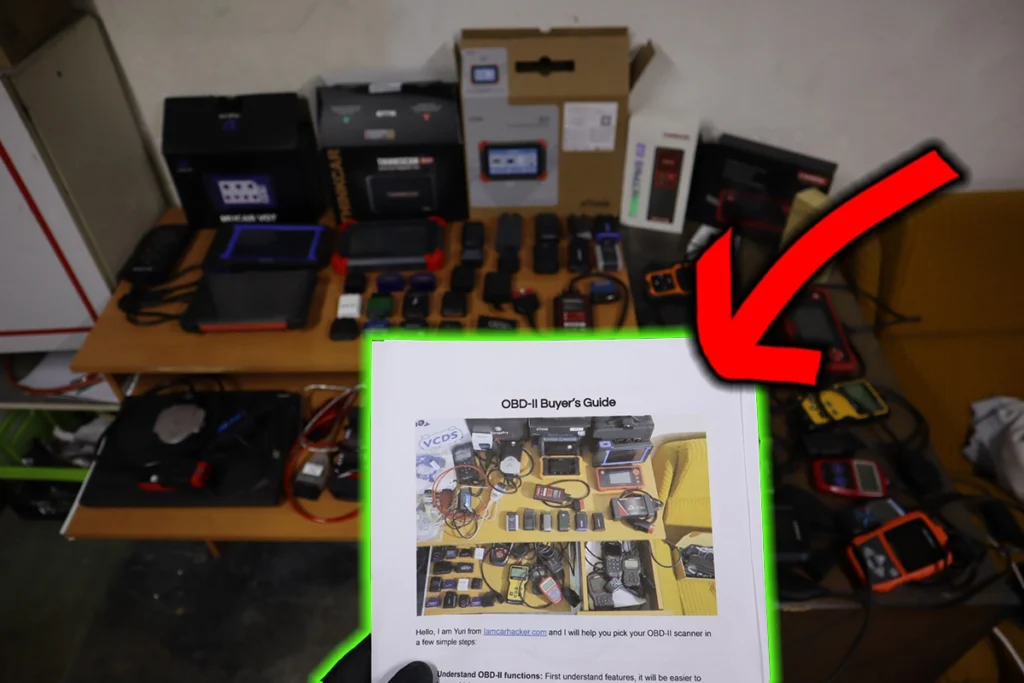The OBD2 code P06B6 signals an issue with the “Internal Control Module Knock Sensor Processor 1 Performance,” indicating that the processor responsible for interpreting the engine’s knock sensor data is not functioning correctly. This can lead to engine knocking, poor performance, and decreased fuel efficiency, as the vehicle’s powertrain control module (PCM) fails to accurately process signals from the knock sensor.
P06B6 quick overview
| Meaning | P06B6: Internal Control Module Knock Sensor Processor 1 Performance |
| Is it serious? | Yes, it can lead to engine damage if not addressed promptly. |
| Possible causes | – Faulty knock sensor or wiring harness – PCM programming errors – Incorrect knock sensor mounting – Vacuum leaks or intake manifold issues |
| How to diagnose? | Inspect the knock sensor and wiring for damage or corrosion. Test knock sensor functionality using a digital multimeter. Check the PCM for programming errors or internal malfunctions. Examine engine’s ignition timing and fuel delivery for proper operation. Replicate driving conditions to diagnose the knocking issue. |
P06B6 Meaning
When your vehicle shows the P06B6 code, it means there’s a problem with a part of the car’s brain that listens for specific noises (knocking) in the engine. This knocking can be bad news because it usually means the engine is not running as smoothly as it should, which can cause damage over time.
The code could point to issues with the sensor that detects the knocking, problems with the wiring that connects everything, or even mistakes in the car’s onboard computer settings. Fixing this issue might involve checking the sensor, making sure all the wires are connected properly, or updating the computer’s software to make sure it understands the sensor’s signals correctly.
Free PDF: How to choose OBD2 scanner

I’ve made you a free PDF to choose the OBD2 scanner in 5 minutes.
✅ Which OBD2 scanner is best?
✅ Which type should you get (DIY, Pro, Hobby)
✅ What is the best scanner for the exact brand/feature (e.g best for BMW)
✅ How to get a Bi-Directional tool for as cheap as $40
✅ Discount coupons for scanners
PDF is 100% free and it is designed to help you pick a scanner in less than a few minutes! Not a boring 50-page guide.
Just tell me where to send it.
How to fix P06B6 – learn from mechanics
I looked into P06B6 service cases at iatn.com website where in the private forums the mechanics seek advice from other mechanics. I looked up a bunch of cases to help you decide how to fix your issue and see what would a real mechanic do to solve it.
Case #1: Ford
Vehicle Information 2010 Ford Fusion SE 2.5L Automatic
Issue + Repair History
- Experiencing engine performance issues.
- Stored trouble code: P06B6 (Internal Control Module Knock Sensor Processor 1 Performance).
- No previous repair history mentioned.
- Symptoms include engine knocking and decreased fuel efficiency.
Other OBD2 Codes + Test Results
- Only the P06B6 trouble code mentioned.
- Live data tests show irregularities in knock sensor signal processing.
Mechanic Suggestions
- Inspect the knock sensor wiring harness and connectors for any signs of damage or corrosion.
- Test the knock sensor functionality using a digital multimeter to measure voltage output.
- Check the PCM for any signs of internal malfunction or programming errors.
- Perform a thorough diagnostic of the engine’s ignition timing and fuel delivery systems to ensure proper operation.
- Test the vehicle under various driving conditions to replicate and diagnose the engine knocking issue.
Final Fix After extensive testing, it was found that the PCM had a programming error causing incorrect processing of the knock sensor signal. The PCM was reprogrammed with the latest software update provided by the manufacturer, resolving the P06B6 trouble code and restoring proper engine performance.
Case #2: Subaru
Vehicle Information 2013 Subaru Outback 2.5i Premium 2.5L Automatic
Issue + Repair History
- Engine performance is erratic.
- Trouble code stored: P06B6 (Internal Control Module Knock Sensor Processor 1 Performance).
- No previous repair history mentioned.
- Customer reports intermittent engine misfires.
Other OBD2 Codes + Test Results
- Only the P06B6 trouble code mentioned.
- Live data tests show inconsistent knock sensor readings during engine operation.
Mechanic Suggestions
- Inspect the knock sensor mounting location for any signs of damage or improper installation.
- Test the PCM power and ground circuits to ensure proper voltage supply.
- Check for any aftermarket modifications that may interfere with the knock sensor operation.
- Perform a comprehensive inspection of the engine’s mechanical components for any issues contributing to engine knocking.
- Conduct a thorough examination of the vehicle’s fuel system to ensure proper fuel delivery and pressure.
Final Fix Upon inspection, it was discovered that the knock sensor was improperly mounted, leading to unreliable signal transmission to the PCM. The knock sensor was repositioned and secured according to manufacturer specifications, resolving the P06B6 trouble code and eliminating the engine misfire issue.
Case #3: Mazda
Vehicle Information 2011 Mazda 3 i Touring 2.0L Automatic
Issue + Repair History
- Experiencing engine hesitation during acceleration.
- Stored trouble code: P06B6 (Internal Control Module Knock Sensor Processor 1 Performance).
- No previous repair history mentioned.
- Customer complaints of reduced engine power.
Other OBD2 Codes + Test Results
- Only the P06B6 trouble code mentioned.
- Live data tests indicate fluctuations in knock sensor voltage output.
Mechanic Suggestions
- Inspect the knock sensor for any signs of physical damage or contamination.
- Test the wiring harness and connectors for proper continuity and resistance.
- Perform a visual inspection of the engine bay for any loose or disconnected components.
- Check for any vacuum leaks or intake manifold issues that may contribute to engine hesitation.
- Conduct a thorough inspection of the engine’s timing components to ensure proper alignment.
Final Fix After thorough testing, it was determined that the knock sensor wiring harness had a loose connection, causing intermittent signal loss to the PCM. The wiring harness was resecured, resolving the P06B6 trouble code and restoring normal engine performance.
How to diagnose P06B6
I made you an overview of solving this DTC, based on all the advice that was suggested by certified mechanics to address this issue in previously mentioned service cases.
| Diagnostic Step | Brief Explanation |
|---|---|
| Inspect knock sensor and wiring | Look for signs of damage, corrosion, or loose connections. |
| Test knock sensor functionality | Use a multimeter to check voltage output and performance. |
| Check PCM programming and functionality | Ensure the PCM is correctly interpreting sensor signals. |
| Examine engine’s ignition and fuel delivery systems | Verify systems are operating correctly to prevent knocking. |
| Replicate and diagnose driving conditions | Identify when and how the engine knocking occurs. |
| Inspect sensor mounting and engine components | Ensure the sensor is correctly installed and engine parts are in good condition. |
| Test PCM power and ground circuits | Verify the PCM receives proper voltage. |
| Check for vacuum leaks or intake issues | Identify any leaks that could affect engine performance. |
| Secure wiring and connections | Fix any loose connections to ensure signal integrity. |
These service cases from a Ford Fusion, Subaru Outback, and Mazda 3 illustrate the importance of accurate knock sensor processing for engine performance. Incorrect sensor readings, mounting issues, or PCM errors can all trigger the P06B6 code. Addressing this code promptly can prevent further engine damage, ensuring smooth and efficient operation.
Free PDF: How to choose OBD2 scanner

I’ve made you a free PDF to choose the OBD2 scanner in 5 minutes.
✅ Which OBD2 scanner is best?
✅ Which type should you get (DIY, Pro, Hobby)
✅ What is the best scanner for the exact brand/feature (e.g best for BMW)
✅ How to get a Bi-Directional tool for as cheap as $40
✅ Discount coupons for scanners
PDF is 100% free and it is designed to help you pick a scanner in less than a few minutes! Not a boring 50-page guide.
Just tell me where to send it.

Hi, I am Juraj “Yuri” Lukacko. I got frustrated by unhelpful and scammy mechanics, so I decided to learn everything about car diagnostics myself. I test dozens of new car diagnostic tools every month along with learning new strategies to fix and customize cars. About Juraj Lukacko (Yuri)